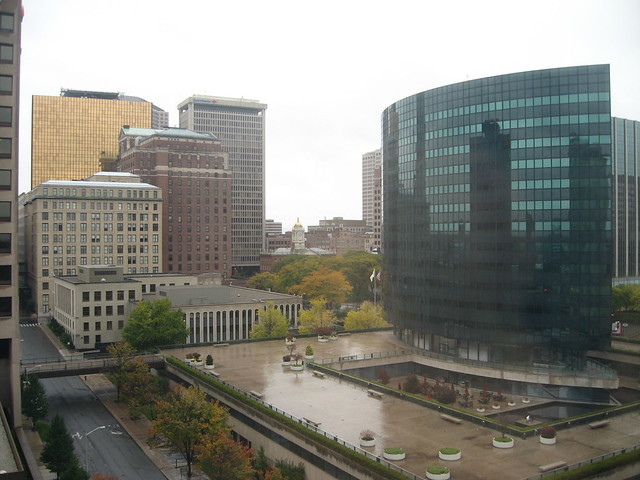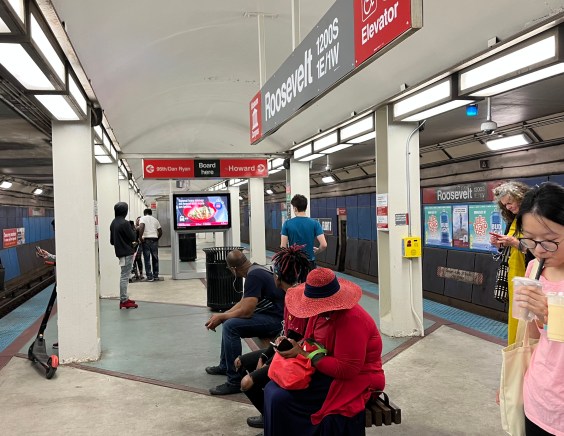
Streetsblog's Parking Madness competition has highlighted the blight that results when large surface parking lots take over a city's downtown. Even though Rochester, winner of 2014's Golden Crater, certainly gains bragging rights, all of the competitors have something to worry about: Cumulatively, the past 50 years of building parking have had a debilitating effect on America's downtowns.
Streetsblog recently spoke with Chris McCahill of the State Smart Transportation Initiative in Madison, Wisconsin, to learn about his research into how parking affects small cities' downtowns. Most recently, McCahill and his co-authors have shown how policy makers' preoccupation with parking not only hollows out city centers, it also decimates the downtown tax base.
McCahill began his analysis as a University of Connecticut Ph.D. student in 2006, choosing to compare the postwar evolution of six small, built-up, relatively slow-growing cities: Arlington, Virginia; Berkeley, California; Cambridge, Massachusetts; Hartford, Connecticut; Lowell, Massachusetts; and New Haven, Connecticut. For each of these cities, McCahill and his collaborators, most frequently professor Norman Garrick, have gone far beyond the usual publicly available statistics and hand-measured the number of parking spaces (both on- and off-street) and the size of buildings from aerial photos.
The resulting analysis shows how three of these cities have diverged from the other three since the base year of 1960. Arlington, Berkeley, and Cambridge went against the postwar grain and chose a "parking-light" approach: emphasizing transportation demand management (TDM) measures, while de-emphasizing driving and in one case even penalizing parking construction. Hartford, Lowell, and New Haven chose a conventional approach, emphasizing that downtown development should provide "adequate" parking based upon standards of the time.
These two paths led these cities to very different outcomes, which McCahill has chronicled in a series of publications. Most recently, he co-authored two papers about how parking has affected the six downtowns' urban fabric and their tax bases. Parking lots take a big bite out of the conventional cities' tax bases, which could reap 25 percent more in downtown property taxes had they chosen a parking-light approach instead.
At first glance, the two sets of cities might seem to have little in common, so why compare them? But "if you trace back 50 years," McCahill says, "those differences vanish." The six cities looked remarkably similar at the start of the study period; they were all small cities, with a mix of old and new industries. Most had about 0.5 parking spaces per 1,000 square feet of building, though Arlington and Berkeley, the newer cities, had much more. On average, each downtown devoted 5 percent of its land to off-street parking and 25 percent to buildings, which on average were about three stories high. Arlington was actually the low-density outlier at this time, with only 16 percent building coverage downtown.

Since 1960, McCahill says, the cities "represent the full range of opportunities" in transportation policy choices. The conventional cities made the decisions to prioritize parking and driving typical of so many other American cities at the time. Arlington, Berkeley, and Cambridge belonged to a much smaller group of cities which recognized that cars "created a tradeoff: Do you make a dense, valuable urban place, or an area where you can drive easily?" As McCahill says, "You're not going to be able to do both really well."
McCahill's research is "an exercise in tracing how the built environment changed" in these cities over time: "Buildings got scrunched onto smaller areas. They got taller, and [were] surrounded by parking." The average downtown in 2000 was still only 24 percent covered by buildings. What changed was the parking footprint: In the parking-light cities, off-street parking remained at 5 percent of land, while it tripled in the conventional cities to 17 percent of land. The buildings got much taller, by over 50 percent in the three conventional cities -- but because land was lost to parking, the total building area increased by much less.
The three conventional cities thought that "you have to supply a lot of parking in order to do well," McCahill says. "You kind of see the Le Corbusier or GM Futurama vision of cities playing out" while walking around these cities. Easy auto access, high speed roads, fewer but taller buildings. These cities adopted high minimum parking requirements for new office towers, they built public and private garages, and they subtly encouraged parking by taxing buildings rather than parking lots.
McCahill studied Hartford in particular detail. Despite a 27 percent increase in downtown development, high-rises packed the resulting development onto 13 percent less land, opening up 120 acres for surface parking -- enough to pave over Disney's Magic Kingdom. "A lot of the parking supply is for the state offices there, and they also built a lot of expensive parking structures," eviscerating the downtown in the process, and yet still falling short of the zoning code's parking mandates.

Much of the money that Hartford spent on downtown went to triple the number of parking spaces, pushing up costs for people spaces. Either "you're bundling [parking] costs in with rent, or taking it out of employee's wages," McCahill says, but ultimately, "someone's always paying for it. When you don't put those costs up front, you're distorting the market and not allowing people to make informed travel decisions."
The parking-light cities allowed various methods to opt out of parking minimums, and thus managed to build healthy downtowns with parking ratios that are 25 to 58 percent lower than the other three cities. Arlington and Cambridge, in particular, dramatically expanded their downtown building stock (by 174 percent and 46 percent, respectively), while only paving 1 to 2 percent of their downtown land for off-street parking.
"The only thing" that minimum parking requirements do is "drive up those [parking] numbers," says McCahill. They turn every development decision into a parking decision: "We've seen parking requirements deter developers from adapting older buildings, changing their land uses" to adapt to new uses. "Meet[ing] those minimum requirements... transforms the land use and the tax base."
And does it ever transform the tax base. What really created the parking craters strangling downtown Hartford, says McCahill, is "a backwards tax structure which discourages development. When buildings came down, parking became the most productive [low-cost] use of the land." In one of their papers, McCahill, Garrick, and co-authors Carol Atkinson-Palombo, Bryan Blanc, and Michael Gangi calculated just how backwards this property tax structure is.
Parking lots, it turns out, return 83 to 95 percent less property tax revenue to a city per acre than buildings do, providing a big incentive for landowners to tear down buildings and pave parking lots instead. By having spent the past 50 years building parking lots instead of buildings, the three conventional cities forego a "parking opportunity cost" of 21.5 to 29 percent of their downtown tax base, whereas the parking-light cities do not. In Hartford, that amounts to $21.78 million a year in revenue. Cumulatively, underpricing land used for parking results in downtown's overall tax productivity taking a huge hit -- similar to how Joe Minicozzi found that parking-laden suburban retail (usually prized by municipalities for its fat tax payments) returns much less in property taxes than compact, in-town development.
"Your tax structure should encourage the type of development that you want," says McCahill, rather than "potentially discouraging the types of land uses you want" through minimum parking ratios and distortionary taxes. Some of the cities take this approach and tax parking lots more heavily. In Arlington, Cambridge, and New Haven, healthy employment bases set a high market price on parking, and parking structures are taxed like other buildings.
What's next for the UConn parking team? McCahill promises that upcoming research will take a broader look. Although the researchers currently have historical data for only six cities, "we have 14 cities that we know what parking looks like [today]." They expect to start "pinning down exactly what [parking supply] means for travel behavior in those cities." Their future efforts could potentially uncover "how effective parking management is in a city's" efforts to manage travel: For all the debate over road pricing, parking pricing is an often-overlooked but effective means to influence travel behavior.
As for this year's Parking Madness, McCahill, who lives in Chicago, was rooting for the home team. Having seen the United Center, Chicago's entry in the contest, McCahill "was blown away by how big that parking crater was. I've been to that stadium," taking the 'L' to the nearest station, "and I was shocked when I left that the streets were gridlocked. Nobody was taking the train."





